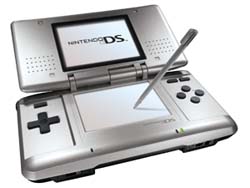
NEW YORK (CNN/Money) � In June 2001, Nintendo launched the Game Boy Advance � and gamers cheered. Twenty-one months later, the company rolled out the Game Boy Advance SP � and that cheering turned into an ovation.
Now we're just shy of 21 months since the GBA SP's launch. And the company has yet another handheld gaming system - the Nintendo DS - hitting shelves.
Gamers are still cheering, to be sure, but the landscape is changing. When the Game Boy Advance cousins came out, Nintendo didn't have a serious competitor for the handheld market. Today, Sony's (Research) PSP is hiding in the shadows � and 2005 could see a fierce battle for portable gaming dollars.
The PSP is positioning itself as a mobile media device as much as a game machine. And it won't hit U. S. shores until at least next March. That means the DS, which will retail for a consumer-friendly $150, has the chance to build momentum through the holiday season.
So far, Nintendo appears to be doing that. The company will ship 2 million units worldwide this year � and said it expects to quickly sell out of the 1 million being launched in the U.S. To meet higher-than-expected demand Nintendo has brought in a third factory to help with manufacturing. The company also recently raised its sales estimates for the DS to 4 million (from 3.5 million) by the end of its fiscal year (March 31, 2005).
Nintendo has never been afraid to take hardware risks � and the DS is an especially strong example of that. With two screens, a touch pad and a built in instant messaging service, it's not a repackaging of what's already on the market. (It's also not small: While other companies are doing all they can to shrink their machines, Nintendo went the opposite route. The DS isn't clumsy by any means, but it's not slim.)
 |
|
| The Nintendo DS |
The dual screens are surprisingly easy to get used to. The DS's top monitor shows what's happening in the game while the lower screen, with its touch-pad functionality, is used to help control the action. (The system also has more standard controls, used in conjunction with the touch-screen.) It's a revolutionary way to play games � but it does take some getting used to.
In an industry that relies too heavily on sequels, licenses and franchises these days, though, revolutionary is welcome � as long as it's fun. The DS generally passes this test, especially when developers reach deep into their imagination and try something truly unique. Of the system's six launch titles, Sega takes the innovative crown with "Feel the Magic," creating a) the strangest video game � ever and b) a game that's impossible to put down.
"Feel the Magic" relies almost completely on the DS' touch-pad, challenging you to win the girl of your dreams by performing stunts like you'd find on MTV's "Jackass". Through rubbing, blowing and shouting at the screen, you'll get closer to your goal.
If you'd prefer something a little closer to the mainstream, Nintendo was smart enough to correct the most egregious error it made with the GameCube's launch � ensuring it had a Mario title ready on Day One. The DS offers a remake of the immensely successful "Super Mario 64," including dozens of mini-games that add to the game's charm.
While only six games will be available when the DS hits shelves, Nintendo said that number will jump to between 10 and 12 within the first 30 days. By the end of the first quarter of 2005, the system will have 20-25 games available. The DS also plays any of the 550 existing titles for the Game Boy Advance.
While it certainly has refreshing characteristics, the DS is not a perfect system. With its size (put two GBA SPs side by side and you'll have a rough idea of its height and width) and unique ways of controlling games, it can cause your hands to cramp a bit after playing for long periods. Unlike the GBA, though, you can put the DS on a flat surface and continue playing with many games, which makes that less of a problem than it sounds.

| |
|
Want more gaming news and commentary? Click Mario Morris.
|
|
The learning curve for using the stylus will likely be the biggest hurdle for gamers. I showed the system to a veteran game developer recently, who got bit frustrated trying to control the onscreen action. While you can use your finger or a thumbpad attached to the DS's wristband, the stylus gives you more precise control, which is essential in some games. It takes a good hour of playing to begin to master the stylus controls.
Aside from games, the DS comes with a built-in instant messaging system that should appeal to the growing "tween" audience (a demographic group hovering between the early teen years and the mid-20s). Chatting with other DS owners in close proximity is easy � and the system's ability to utilize wireless networks to connect to the Internet makes the DS a good on-the-go messaging system for gamers.
Those wireless abilities also constitute a policy shift of sorts for Nintendo � which hasn't done much to support online play before this.
That hasn't stopped the company from dominating the handheld market however. With over 170 million Game Boys sold in the last 15 years, Nintendo has a rock-solid fan base. The DS should help it expand that base in a couple of directions � with core gamers who long for creativity and innovation and with tweens for whom communications is just as important as gaming.

Morris is Director of Content Development for CNN/Money. Click here to send him an email.
|

